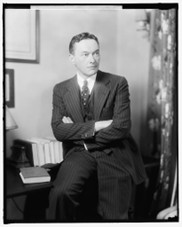Walter Lippmann (1889-1974), American journalist, public philosopher and Pulitzer Prize winner.
© Article written by Gabriel Godeffroy for the Central Europe Foundation
Photo: Harris & Ewing, “Walter Lippmann”, Library of Congress
After studying at Harvard University, Walter Lippmann began a career in journalism. In November 1914, he was one of the founding editors of the New Republic, in which he advocated the end of American isolationism. At the end of the First World War, Lippmann was “asked to join the staff of the Inquiry, a non-governmental and largely clandestine outfit that had been established […] to draw up American peace terms”. As its Secretary General, he participated in the drafting of Woodrow Wilson’s famous “Fourteen Points” program. After the First World War, Lippmann participated in the Paris Peace Conference as a member of the American delegation. Returning to the United States of America, he opposed the ratification of the Versailles Treaty which was, “to him, as to many others”, such as the British economist John Maynard Keynes, whom he had met in Paris, “a disillusioning experience”.
During the interwar period, Walter Lippmann became one of the most influential journalists and “columnists”, writing for the World and the Herald Tribune in New York, as well as a renown public philosopher. Following the International Economic Conference, which was held in London in June-July 1933, Lippmann started working on liberalism. His research led to the publication of "The Good Society" in 1937, which laid the foundations for the famous
“Lippmann Colloquium”, which marked the renewal of liberal thought. In the aftermath of the Second World War, he expressed his support for the Marshall Plan for the economic reconstruction of Europe.
--Alain Clément, "La mort de Walter Lippmann : une page d’histoire américaine", Le Monde, 17 décembre 1974.
--Richard H. Rovere, “Walter Lippmann”, The American Scholar, Autumn 1975, Vol. 44, No. 4, p. 585-603.
--Ronald Steel, Walter Lippmann and the American Century, Boston/Toronto: Little, Brown and Company, 1980.

